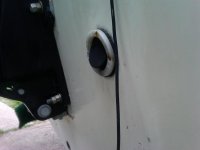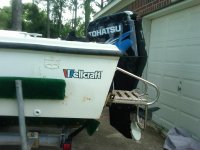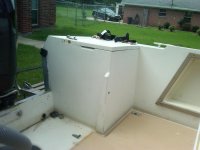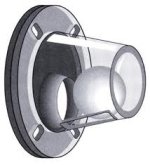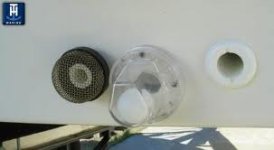I have a 18 Fisherman CC that seems to get a lot of water in the bilge and was wondering if somebody could explain to me how the self draining works on the V20 (which should be the same as mine?)? I have the two white drains with the cross in them in the floor in the channels that lead to the two holes on the bottom port/starboard sides and the water obviously drains to the port/starboard thru hull fittings. Sorry for the stupid question but how do they drain water when they are below the water line? Check valve?
I just repowered and the two drain holes in the transom seem to stay right at the water line so I have to keep transom plugs in them now. Don't recall if the old JohnnyRude which weighed about 25 lbs less made the boat do this as well.
I'm adding a second bilge (RuleMate 1500) as the primary to go along with the existing Rule 500 manual pump I inherited and will make it the backup. I have to cut a new hole for the 1 1/8 thru hull fitting and the new line I'm going to add. I've also bought a Rule bilge alarm I'm going to add.
I want to run both the alarm straight to the battery as well as the new 1500 bilge pump. Is this an acceptable practice? Do I need to install the suggested 1 amp (alarm) and 10 amp (pump) if I do this? The 500 gph pump will stay on a manual switch.
I'm going to move the 500 gph pump and install the alarm on a 2x4 piece of treated wood so they will sit slightly higher. Is this high enough?
Thanks for any advice/help.
I just repowered and the two drain holes in the transom seem to stay right at the water line so I have to keep transom plugs in them now. Don't recall if the old JohnnyRude which weighed about 25 lbs less made the boat do this as well.
I'm adding a second bilge (RuleMate 1500) as the primary to go along with the existing Rule 500 manual pump I inherited and will make it the backup. I have to cut a new hole for the 1 1/8 thru hull fitting and the new line I'm going to add. I've also bought a Rule bilge alarm I'm going to add.
I want to run both the alarm straight to the battery as well as the new 1500 bilge pump. Is this an acceptable practice? Do I need to install the suggested 1 amp (alarm) and 10 amp (pump) if I do this? The 500 gph pump will stay on a manual switch.
I'm going to move the 500 gph pump and install the alarm on a 2x4 piece of treated wood so they will sit slightly higher. Is this high enough?
Thanks for any advice/help.

